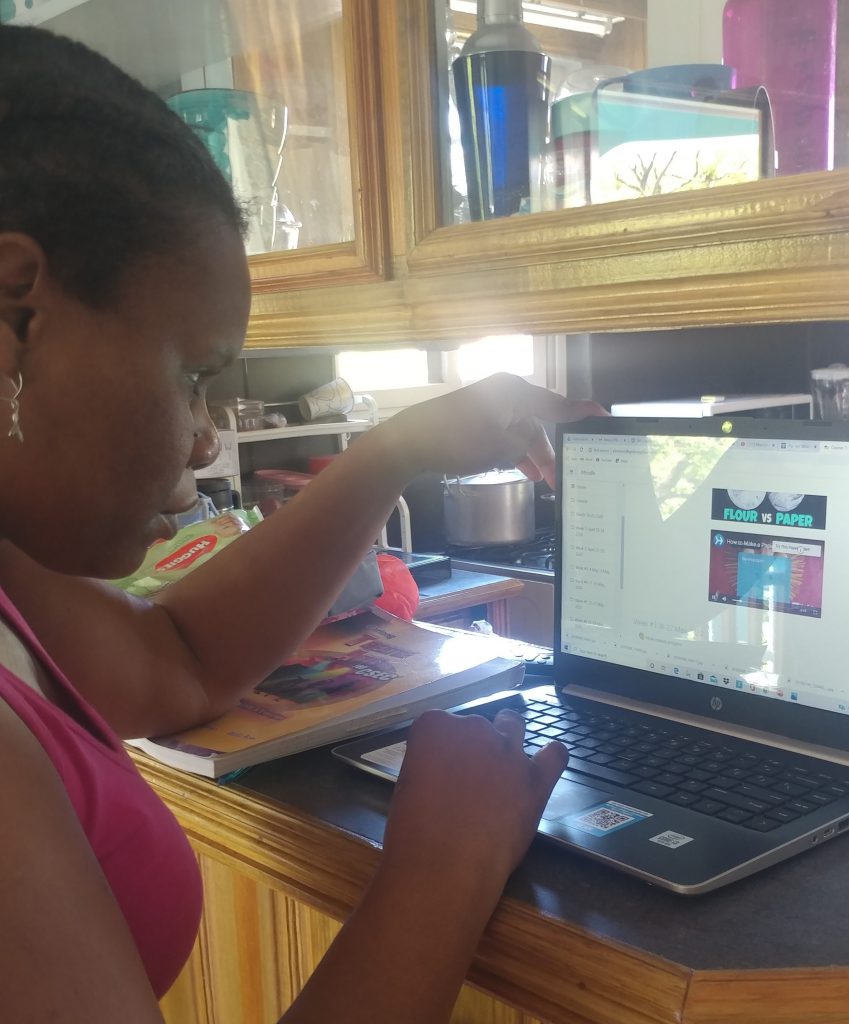COVID-19 Talks: The Suddenness of Virtual Teaching. How One Teacher and Her School Adapted
by Lou-Ann Jordan Jun 1, 2020

It’s common knowledge, electronic devices and teachers, for that matter schoolwork, do not mix!
That was until a few months ago, tasked with finding innovative ways to carry on educating our children in the face of the COVID-19 pandemic, our education administrators, teacher and parents had to rely on those very devices.
Memes abounded at this seeming contradiction or rather the ironic turn of events. It was a new situation for everyone, and teachers throughout the Caribbean rose to the challenge. For some schools, virtual learning had been part of their practice, though to a lesser degree, so they were better prepared. However, other schools and their teachers had to adapt very quickly.
And, as schools doors remain shut, schools and teachers, as well as students, are adjusting to this new way of learning. Schools and their teachers are quickly learning what works and what doesn’t and restructuring their techniques to carry out their mission.
Read on to learn about the experience of Neila Ettienne, English Literature and Theatre Arts teacher at Presentation Brothers College. Ms Ettienne teaches forms one through four.
What were your thoughts when you first heard of COVID-19?
When I first heard of COVID-19, well at first they were just calling it a new strain of the Coronavirus, which came out of a meat market in China. At the time, this was back in December; I treated the information as another news article. However, by January, it had become more prominent in the news, but I felt sure it would blow over soon. I remember thinking there was no need to panic; after all, it was in China—far away. I thought they would contain it.
When the virus first made its way to the Caribbean, what were your thoughts on how it would impact you as a teacher and your students?
I knew that my life as a teacher in Grenada was about to change drastically. I was concerned about being able to complete my syllabus and the transition to teaching students online. I knew that not all my students had the capacity and resources to make the change.
Also, the impending economical changes that I knew we would experience were frightening. I knew people would lose jobs, and even that would have an impact on my role as a teacher, as it would affect some of my students.
Before COVID-19 was virtual teaching practised in your school? If yes, in what ways?
Fortunately, my school was in the process of setting up, Moodle, an online learning platform. Also, some teachers were already using Edmodo. With the impetus of COVID-19, my school management team decided to use Moodle for forms one and two, and Edmodo for forms three through five.
Thankfully, I had the foresight to move all my planning online: weekly outlines, scheme of work etc. So, that made the transition even more seamless.
How have your students responded to the shift to online learning?
For some students, it has been a smooth transition, while for others not so good. We are still struggling to get 100% of our students online.
In the first week, understanding the platform was our greatest challenge. Students were having problems logging in; some kept forgetting passwords, and most had to create new email accounts.
Our greatest challenge was and still is that not all students have internet access, and some do not have devices on which to complete assignments. In cases where there is a computer in the house, there is much competition for it between parents who are currently working from home and siblings in different grades, and at different learning stages.
What do you see as some of the benefits to this style of teaching?
There are quite a few that quickly comes to mind. For instance, students can learn from the comfort of their home. And, home-study allows for parents to save on uniforms, meals and transportation costs. For learning, students get easy, personalised, and meaningful feedback, especially as the teacher doesn’t have to deal with the entire class all at once.
Also, students get to work at their own pace, even while they can collaborate. Virtual learning allows students to share their work easily with each other, as well as learn from one another. It also supports easy access to their grades and tracking of their progress. The latter, parents, can certainly appreciate.
Similarly, for teachers, there is more opportunity to explore other resources online. I enjoy having the use of various strategies and teaching tools to keep my students motivated. We can also enhance our lessons, making them more engaging.

What two challenges does this method present to teachers?
A notable challenge is arresting the attention of students that are tactile learners; to them, lesson presentations may seem dull and boring. To avoid monotony, we have to find ways to keep our lessons fresh and engaging continuously.
Additionally, not all students have their own devices, and so some may get the work done more frequently than others.
What measures have you employed to combat these challenges, which other teachers may find useful?
Cognizant that my students have varying learning styles I’ve altered my syllabus quite a bit to accommodate the different types of learners.
Also, I’ve added a lot more video content and have started using ‘Forum’. Forum is an excellent tool. It’s a part of Moodle. It allows students to have discussions, and they get to express themselves. I have my students use it for posting and responding to their classmates’ work. I’ve made their interaction mandatory; they have to post to at least two students to get grading credit. I also vary my assessment strategies.
Above all those things, understanding the challenges some students have in accessing devices, among other things, I’ve found practising patience is best. We have to extend tolerance to the parents, students and even to ourselves.
In what significant way can parents make this period seamless and meaningful for their children?
I think parents can benefit from getting to know the teaching platforms; this may help them to be more supportive of their child.
Teachers have always urged parents to be a part of their child’s education, and this is the perfect opportunity for them to do so.
This new style is an adjustment for teachers also, what kind of support would you like as a teacher and are you receiving it?
The volume of work and the fact that there wasn’t a transition period has made it very challenging. So, having more training opportunities would be extremely helpful. Also, we are overworking our computers and mobile devices. I wish we had more support there that is if it isn’t already forthcoming.
Yello thanks Neila Ettienne for her candid contributions.








